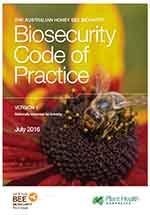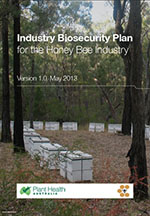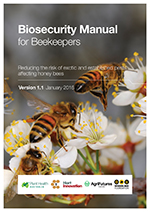
Biosecurity planning provides a mechanism for the honey bee industry, government and other relevant stakeholders to assess current biosecurity practices and future biosecurity needs. Planning identifies procedures that can be put in place to reduce the chance of pests reaching our borders or minimise the impact if a pest incursion occurs.
A number of resources and programs have been undertaken to prepare the honey bee industry for a biosecurity emergency. They include preparation of an industry biosecurity plan, identification high priority exotic pests of the industry, biosecurity manuals for beekeepers, surveillance programs, funding for pest emergencies, and other initiatives.
 The Australian Honey Bee Industry Biosecurity Code of Practice (the Code) has been developed in consultation with beekeepers and governments to provide a framework for Australian beekeepers to use best-practice biosecurity measures.
The Australian Honey Bee Industry Biosecurity Code of Practice (the Code) has been developed in consultation with beekeepers and governments to provide a framework for Australian beekeepers to use best-practice biosecurity measures.
The Code has been developed to incorporate fundamental biosecurity principles into the practices of all Australian beekeepers.
Some sections of the Code are already mandatory under existing state and territory legislations. Some parts of the Code apply to all beekeepers; others apply only to beekeepers with 50 or more hives.
 The Industry Biosecurity Plan for Honey Bee Industry outlines key threats to the industry, risk mitigation plans, identification and categorisation of exotic pests and contingency plans. It provides a mechanism for industry, governments, and stakeholders to better prepare for, and respond to, incursions of exotic plant pests that could have significant impacts on the honey bee industry.
The Industry Biosecurity Plan for Honey Bee Industry outlines key threats to the industry, risk mitigation plans, identification and categorisation of exotic pests and contingency plans. It provides a mechanism for industry, governments, and stakeholders to better prepare for, and respond to, incursions of exotic plant pests that could have significant impacts on the honey bee industry.
For a copy, please contact Plant Health Australia on 02 6215 7700 or email admin@phau.com.au
 The Biosecurity Manual for Beekeepers provides information for the industry and producers about biosecurity practices and honey bee pests.
The Biosecurity Manual for Beekeepers provides information for the industry and producers about biosecurity practices and honey bee pests.
The manual is for anyone who keeps honey bees in Australia, from commercial operators, to backyard enthusiasts and people starting up their first hives.
Each and every beekeeper has a role to play in protecting honey bees from established and exotic pests. Incorporating these recommended biosecurity processes into day-to-day operations is the best way to protect individual beekeepers, regional biosecurity and the Australian honey bee industry as a whole.
The honey bee biosecurity training module contains information that is present in the biosecurity manual in an online format and questionnaire. Its aim is to maximise the early detection of bee pests (specifically Varroa mites), and minimise the spread of potential pest incursions though improved understanding of the importance of biosecurity, best management practices and basic awareness of key pest threats.
For more information about BOLT, or to complete the honey bee biosecurity module click here.
The Emergency Plant Pest Response Deed (EPPRD) is a formal, legally binding agreement between the Australian Government, state and territory governments, plant industry signatories and Plant Health Australia. As a signatory to the EPPRD, the Australian Honey Bee Industry Council (AHBIC) has a seat at the decision making table and also contributes to funding if an approved response plan is implemented to eradicate an emergency plant pest.
Under this agreement the Australian honey bee industry has a responsibility to report suspect pests. The earlier a new pest is detected, the greater the chance an eradication response will be mounted and the more likely it will be successful.
Under the EPPRD, beekeepers may qualify for owner reimbursement costs (ORCs) for direct costs incurred as a result of the implementation of an approved response plan. Reimbursement may apply to direct beekeeper losses such as the destruction of the honey bee colony, hive parts and/or honey stocks. They may also cover the replacement of hive material and additional chemical treatments.
Calculation of reimbursements is prescribed in the EPPRD, including the different formulae used to accommodate the wide range of crops grown by industry signatories. Honey bee payments are calculated using the ‘Bees, hives, honey and associated products’ formula. To ensure that these calculations are accurate, beekeepers should keep records of key information. It is important to remember that payments only apply to approved response plans aimed at eradication, which are more likely to be developed following early reporting.
More information about the EPPRD.
More information about record keeping.
 National Bee Pest Surveillance Program
National Bee Pest Surveillance ProgramThe National Bee Pest Surveillance Program is an early warning system to detect new incursions of exotic bee pests and pest bees. The program involves a range of surveillance methods conducted at locations considered to be of most likely entry of bee pests and pest bees throughout Australia.
More about the program